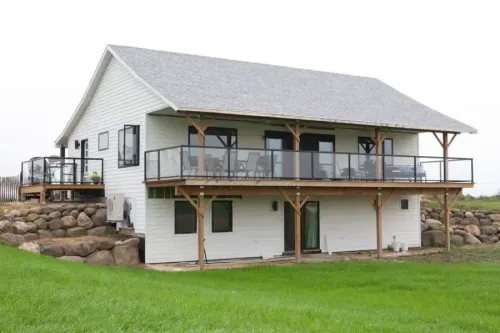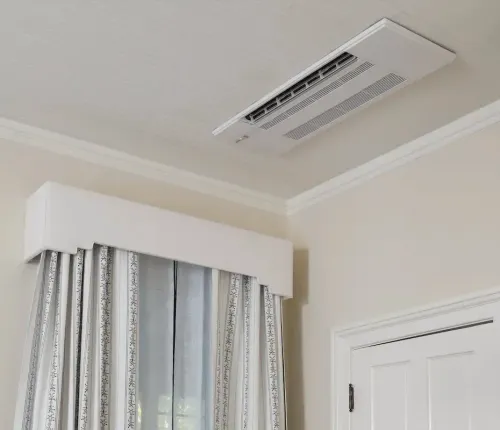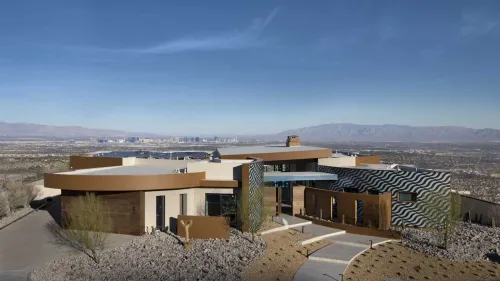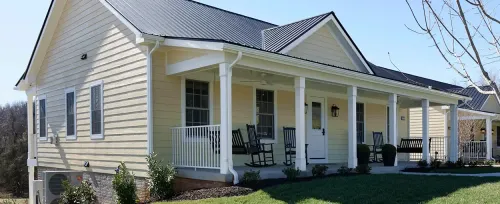Project Location: Sonoma, California
Completion Date: October 2010
Challenge
Retrofitting a 47-year-old farmhouse with a comfortable, energy-efficient HVAC system to meet Passive House standardsSolution
A split-ductless heating and air-conditioning system from Mitsubishi ElectricResult
A highly efficient home mixing 1960s architectural charm with modern HVAC capabilities
When bank manager Catherine O’Neill retired in the California wine country in 2009, she decided she wanted a comfortable and environmentally friendly retirement home that made a distinct energy-efficiency statement. In a cul-de-sac of early 1960s ranch houses a few blocks from the central plaza in historic downtown Sonoma, Calif., she discovered a run-down 1962 farmhouse that had not been lived in for years but had “good bones.”
To transform this neglected house into a showcase for energy efficiency, O’Neill knew she would need an experienced team with sustainable design talent. For a team leader she turned to Rick Milburn, founder of PassivWorks, Inc. in nearby Vineberg, Calif. She knew Milburn to be a meticulous master builder and an activist for green building practices. His website was filled with energy-efficient custom homes and happy customers.
Researching the many eco-friendly building options available, Milburn and O’Neill settled on the Passive House (Passivhaus) Standard developed in Germany in 1988. The basic idea of a Passive House is to reduce the overall energy usage of a home by 60 to 70 percent and reduce the heat usage by 90 percent over traditional code-built homes. There are four key elements of a Passive House:
- Super insulation that is airtight and minimizes thermal bridging (cool/ heat loss).
- Highly efficient windows and doors.
- Mechanical ventilation with heat recovery.
- Innovative, efficient cooling and heating technology.
Technically speaking, this means that the maximum cooling or heating demand must not exceed 1.4 kilowatt-hours (kWh) per square foot per year, the total primary energy demand must not exceed 11.1kWh per square foot per year and air infiltration must be less than 0.6 air changes per hour.
Passive House Training And Energy Testing
Milburn took time off from his business to complete the certified Passive House Institute-US (Phius) training in Urbana, Ill. To design the O’Neill retrofit, Milburn called on Jarrod M. Denton, Aia, Signum Architecture, in nearby St. Helena, Calif. Together, they traveled to the annual International Passive House Conference in Darmstadt, Germany, where they attended seminars on design and building techniques for the Passivhaus Standard.
The old farmhouse presented both men with some unique challenges. For starters, the 1,933-square-foot building had no street-front entry: Its odd design consisted of two structures connected by a breezeway. Local zoning regulations required that the building’s footprint remain unchanged. To work around these issues, Denton created a way to connect the two structures with a corridor that became a dramatic new kitchen framing the courtyard. The result was a U-shaped house with an additional 400 square feet of living space.
To address energy performance, Milburn contacted Graham Irwin, founder of Essential Habitat in Mill Valley, Calif. One of the nation’s pioneer Passive House consultants, Irwin performed energy modeling for the house using the Passive House Planning Package (Phpp) software. Phpp accounts for climate, square footage, solar orientation and shading, windows, materials, etc. The software allows for cost-optimization of the building shell and performance. Irwin carried out 76 iterations with Phpp before the actual retrofitting began in August 2009.
Airtight Envelope: Ten Times More Sealed Than Average House
Milburn began by employing the Pressure-equalized Rain-screen Insulated Structure Technique (Persist) to create an airtight envelope. Because Passive House buildings have little tolerance for air leakage, Milburn also used Grace Ice & Water Shield® over half-inch Forest Stewardship Council (Fsc) plywood sheathing, InsulFoam® R-Tech IV expanded polystyrene (Eps), Aerogel Spaceloft, Optima® blowin blanket system (Bibs) fiberglass insulation, Stego® Wrap vapor barrier and Protecto Wrap® Super Stick Building Tape™.
After all this thermal girding, the O’Neill farmhouse now sported a super-insulated metal roof at R-74 and walls at R-31. Milburn brought in new triple-pane Optiwin® windows from Germany that delivered as much insulation (R-9) as many walls in standard residential construction.
Once the windows were installed, the first blower door test was performed to determine the structure’s airtightness. The team was stunned when the test results showed 0.4 air changes per hour — more than 30 percent better than the Passive House Standard requires.
Mitsubishi Electric Systems A Good Match For Passive Homes
For backup cooling and heating, Milburn decided on a split-ductless residential system from Mitsubishi Electric. “For achieving the rigorous Passive House standards, I have found Mitsubishi Electric technology to be the most well-matched system for meeting energy-efficiency goals,” Milburn said. “Their mini-split systems are unique for meeting small cooling and heating loads — the COP [coefficient of performance] is great! The compressors in both the indoor and outdoor units are so quiet one can’t tell they are in operation.”
“The Mitsubishi Electric split- ductless technology was our only option,” said Denton. “For the diminutive cooling and heating demands of this Passive House, the minimum BTU/H capacities of this system for both cooling and heating are the lowest in the industry: All other systems would have been overkill. Also, we liked the fact that the units are so compact — the outdoor unit’s the size of a suitcase.”
Because ventilation is so critical for the sealed envelope of a Passive House, Milburn selected the UltimateAir RecoupAerator® energy recovery ventilator (ERV) as the basis for the mechanical system. Ducts in the bathrooms, laundry room and kitchen exhaust moisture and odors before the ERV strips energy from the outgoing air stream.
Same Energy Cost As Running A Hair Dryer
Since Catherine O’Neill moved into her new Passive House and net metering began, her monthly combined gas and electric bills have averaged less than $20 a month. As the house was unoccupied for years before the renovation, no historical energy data is available for comparison; the house, however, achieved an 80 percent reduction on source energy use when compared to an average California home.
Because of the home’s tight thermal envelope, a single Mitsubishi Electric M-Series system located in the hallway (pictured top, and bottom, background) is sufficient to cool and heat the entire home. The system was chosen because of its ability to function efficiently at partial loads and because the minimum Btu/h capacity would provide the perfect amount of cooling and heating without being too large.
Recently, the O’Neill retrofit was selected by the U.S. Department of Energy’s Building America program as a prototype home. Building America provides a set of guidelines for estimating the energy savings achieved by a package of retrofits or an extensive rehabilitation of an existing home. The O’Neill house report outlines a set of typical operating conditions for creating a building simulation model to compare energy use across the U.S. before and after a series of retrofits is completed.
“We are pleased to have built the first Passive House in California and the first retrofit Passive House in the U.S.,” Milburn said. “Hardly passive, these homes are truly the future of energy-efficient building and the most practical, cost-effective way for us to reduce our daily energy consumption. On the coldest day of the year, Passive Homes can be powered with the same amount of energy it takes to run a hair dryer. This is a tremendous milestone in the American Passive House movement.”
Beautiful, Inviting And Comfortable
“I am thrilled with the house, and I am so happy to have worked with a team of professionals who are so passionate and knowledgeable about Passive House design,” O’Neill said. “My Mitsubishi Electric system is incredibly quiet, and because I am skinny, keeps me toasty warm — 2 degrees above the Passive House standard of 72 degrees [Fahrenheit]. My favorite thing about my house is that, although unbelievably green, it doesn’t look like one of those geeky, architectural experiments. It is not only highly energy efficient, but it’s also beautiful, inviting and comfortable.”
Project Team
- Owner: Catherine O'Neill, Sonoma, California
- Architect: Signum Architecture, St. Helena, California
- Builder: PassivWorks, Inc., Vineberg, California
- Passive House Consultant: Essential Habitat, Fairfax, California
- HVAC Engineer: Path2Passive House, Berea, Ohio
- HVAC Contractor: Accell Heating and Air, Napa, California
Mitsubishi Electric Equipment Installed
- (1) MUZ Outdoor Unit
- (1) MSZ Wall-Mounted Indoor Unit
- (1) PAC Simple MA Remote Controller









